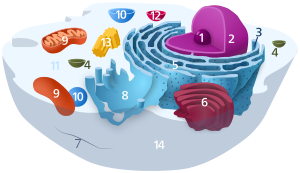Cytoplasmic
| Cell biology | |
|---|---|
| The animal cell | |

Components of a typical animal cell:
|
In cell biology, the cytoplasm is the material within a living cell, excluding the cell nucleus. It comprises cytosol (the gel-like substance enclosed within the cell membrane) and the organelles – the cell's internal sub-structures. All of the contents of the cells of prokaryotic organisms (such as bacteria, which lack a cell nucleus) are contained within the cytoplasm. Within the cells of eukaryotic organisms the contents of the cell nucleus are separated from the cytoplasm, and are then called the nucleoplasm. The cytoplasm is about 80% water and usually colorless.
The submicroscopic ground cell substance or cytoplasmatic matrix which remains after exclusion the cell organelles and particles is groundplasm. It is the hyaloplasm of light microscopy, and high complex, polyphasic system in which all of resolvable cytoplasmic elements of are suspended, including the larger organelles such the ribosomes, , the plant plastids, lipid droplets, and vacuoles.
It is within the cytoplasm that most cellular activities occur, such as many metabolic pathways including glycolysis, and processes such as cell division. The concentrated inner area is called the endoplasm and the outer layer is called the cell cortex or the ectoplasm.
Movement of calcium ions in and out of the cytoplasm is a signaling activity for metabolic processes.
...
Wikipedia
